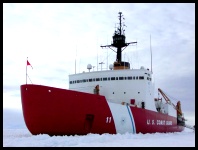
 A Couple of Tough Ships The U.S. Coast Guard's Polar class ships "Polar Sea" and "Polar Star" are two of the largest ships in the Coast Guard and the world's most powerful non-nuclear icebreakers. They're designed to move continuously through six feet / 2 meters of ice at a speed of three knots. Six diesel-electric engines can produce 18,000 shaft horsepower, but when the going gets tough in thick ice, the ships can switch to three gas turbines that can crank out 75,000 shaft horsepower. That power goes to three propellers that push the reinforced steel hull up onto the ice which then breaks under the ship's weight (Details).
In addition to facilities for the crew of 180 men and women (including a library, exercise room, and daily movies), the ships have five laboratories and accommodations for as many as 35 scientists and technicians. Another seven portable science laboratories can be installed on deck.
Click pictures for more information and credits. Library: Arctic, Ice Boats/Ships/Submarines Links: Arctic, Boats & Ships Arctic Maps & Weather Reports |

|
DICTIONARY: Just "double-click" any unlinked word on this page for the definition from Merriam-Webster's Student Electronic Dictionary at Word Central. |

|
ARCTIC LIBRARY & GLOSSARY: Check this section for an index of the rest of the things you really need to know about the Arctic. |

|
ARCTIC MAPS & WEATHER REPORTS: Maps of the Northwest Passage, explorers' routes, iceberg sources, Nunavut, the Arctic by treeline, temperature... |

|
ARCTIC LINKS: Even more information! Links to sites related to the Arctic and "Iceberg: the Story of the Throps and the Squallhoots". |

|
GUIDE TO ARCTIC SUNRISE & SUNSET: How much sunlight or darkness is there in the Arctic on each day of the year? |
to is the property of their respective owners, and Athropolis is not responsible for their content.
